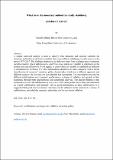What have the monetary authorities really stabilised, and does it matter?
Date
01/02/2023Metadata
Show full item recordAbstract
A simple statistical method is used to identify what domestic and external variables the monetary authorities in different countries have succeeded in stabilising, in each year over the period 1974–2017. The findings emphasise the shift over time from exchange rate to domestic variable (mainly price) stabilisations, and from cases where no variable is stabilised on the criteria used and inflation is 5% or higher, to cases where no variable is stabilised but inflation is constrained to be below 5%. The stabilisations identified are also compared with a recent classification of countries’ monetary policy frameworks, which has a different approach and different sources: the overlaps are considerable but incomplete. The association between the different stabilisations and economic performance in terms of inflation and growth is then examined, through both unconditional and conditional analyses. The clearest finding is that constrained no overall stabilisation is associated with better performance than unconstrained no overall stabilisation, and typically with as good performance as price stabilisation. It is suggested that good macroeconomic outcomes can be obtained in the context of a variety of stabilisations, provided the monetary authorities are ‘serious about inflation’.
Citation
Cobham , D P & Macmillan , P 2023 , ' What have the monetary authorities really stabilised, and does it matter? ' , Open Economies Review , vol. 34 , pp. 43-70 . https://doi.org/10.1007/s11079-022-09668-4
Publication
Open Economies Review
Status
Peer reviewed
ISSN
0923-7992Type
Journal article
Collections
Items in the St Andrews Research Repository are protected by copyright, with all rights reserved, unless otherwise indicated.

